Powerful Foods for Hair recovery & Growth
Healthy, vibrant hair is a reflection of internal health. While genetics and external treatments play a role, nutrition is the foundation for strong, thick, and shiny hair. Deficiencies in essential vitamins, minerals, and proteins can lead to hair thinning, breakage, and slow growth. In this comprehensive guide, we will explore the top 10 scientifically-backed foods that repair damaged hair, prevent hair loss, and boost natural growth, along with detailed insights into how these nutrients work, recipe ideas, and actionable tips to transform your hair health.
Understanding Hair Biology: The Hair Growth Cycle
Before diving into nutrition, it’s crucial to understand how hair grows. The hair growth cycle consists of three phases:
- Anagen Phase (Growth Phase): Lasts 2–7 years. Hair follicles actively produce keratin, the protein that forms hair strands.
- Catagen Phase (Transition Phase): A 2–3 week period where hair stops growing and detaches from blood supply.
- Telogen Phase (Resting Phase): Lasts 3–4 months. Hair sheds naturally, and follicles prepare to restart the cycle.
Nutrition’s Role: Nutrients like protein, iron, and vitamins directly influence the duration and health of the anagen phase. Poor diet shortens this phase, leading to thinner, weaker hair.
How Nutrition Impacts Hair Growth
Hair is primarily made of keratin, a protein requiring amino acids, vitamins, and minerals for synthesis. Here’s how deficiencies affect hair health:
- Protein Deficiency
- Impact: Keratin production slows, causing brittle, weak strands prone to breakage.
- Solution: Aim for 0.8–1g of protein per kg of body weight daily.
- Iron Deficiency
- Impact: Reduces hemoglobin production, limiting oxygen delivery to follicles. Result: shedding and slow regrowth.
- Solution: Pair iron-rich foods with vitamin C for absorption.
- Omega-3 Deficiency
- Impact: Scalp inflammation and dryness, leading to frizz and lifeless hair.
- Solution: Consume omega-3s 2–3 times weekly.
- Vitamin Deficiencies (Biotin, A, C, D, E, Zinc)
- Impact: Weakens follicles, disrupts sebum production, and increases oxidative stress.
- Solution: Eat a colorful, varied diet rich in fruits, vegetables, and nuts.
The Top 10 Foods for Hair recovery & Growth
Let’s explore each superfood in detail, including their key nutrients, scientific evidence, and practical ways to incorporate them into meals.
1. Wild-Caught Salmon – The Omega-3 Powerhouse
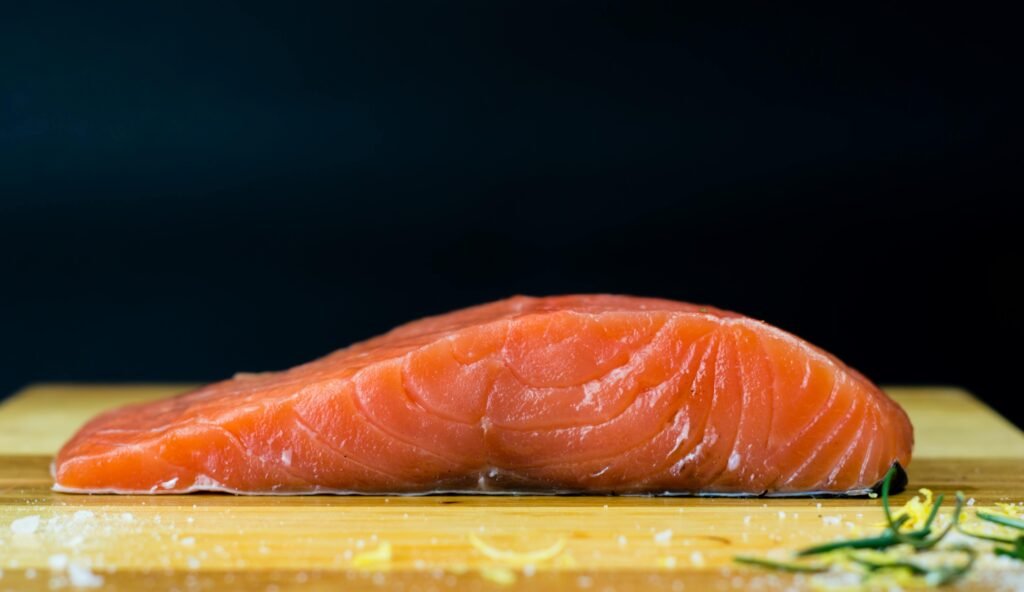
Why It’s Essential:
Salmon is rich in omega-3 fatty acids (EPA & DHA), which reduce scalp inflammation and strengthen hair follicles. It also provides biotin, selenium, vitamin D, and high-quality protein—all critical for keratin synthesis and scalp hydration.
Scientific Insights:
- A 2018 study in the International Journal of Dermatology found that omega-3 supplementation reduced hair shedding in women by 30% over six months.
- Vitamin D in salmon activates hair follicle stem cells, prolonging the anagen phase (per a 2020 study in Nature).
Nutritional Breakdown (Per 100g Serving):
- Calories: 208
- Protein: 20g
- Omega-3s: 2.3g
- Vitamin D: 60% of RDI
How to Include It in Your Diet:
- Grilled Salmon Bowl: Pair with quinoa, avocado, and spinach for a hair-healthy meal.
- Salmon Sushi Rolls: Combine with seaweed (rich in iodine) for added follicle support.
- Vegan Alternatives: Flaxseeds, walnuts, and chia seeds (1–2 tbsp daily).
Considerations: Opt for wild-caught salmon to avoid mercury. Canned salmon is a budget-friendly option.
2. Eggs – The Perfect Biotin & Protein Source
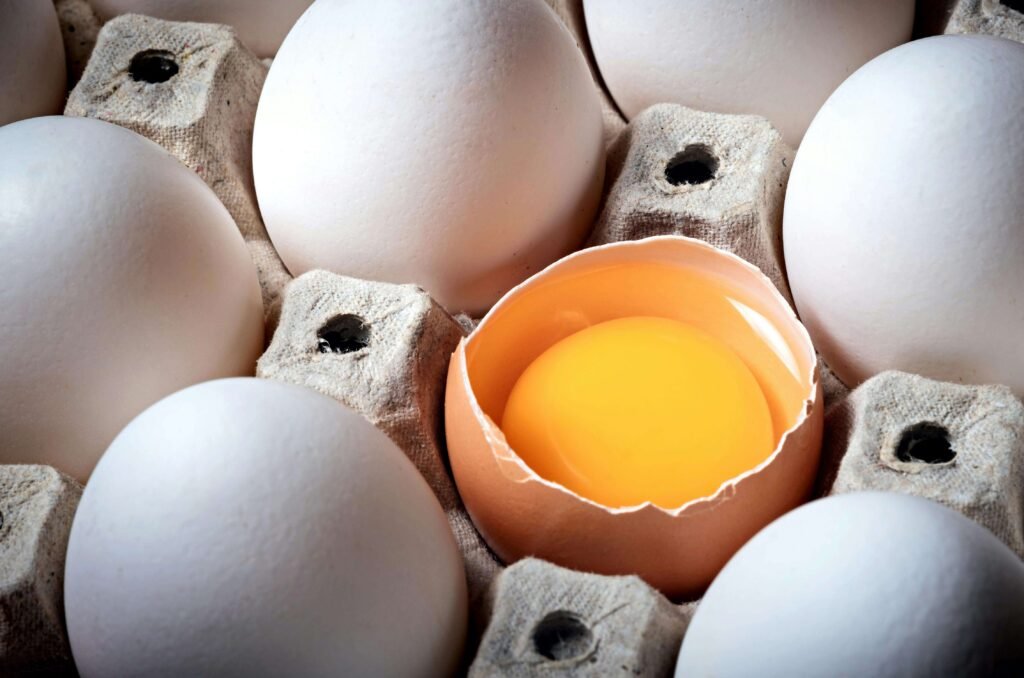
Why It’s Essential:
Eggs are a complete protein source, providing all nine essential amino acids. The yolk contains biotin, vitamin B12, and selenium, which prevent breakage and boost shine.
Scientific Insights:
- A 2017 study in Skin Appendage Disorders found that biotin supplementation improved hair thickness in 90% of participants with thinning hair.
- Sulfur-based amino acids (like cysteine) in eggs strengthen hair bonds.
Nutritional Breakdown (1 Large Egg):
- Protein: 6g
- Biotin: 33% of RDI
- Selenium: 22% of RDI
How to Include It in Your Diet:
- Spinach & Feta Omelet: Add iron-rich spinach and vitamin C-rich tomatoes.
- Boiled Egg Snack: Sprinkle with paprika (vitamin A) for extra antioxidants.
- Vegan Alternatives: Almonds, sweet potatoes, and nutritional yeast.
Pro Tip: Avoid overcooking eggs to preserve biotin content.
3. Spinach – Iron & Folate for Hair Strength
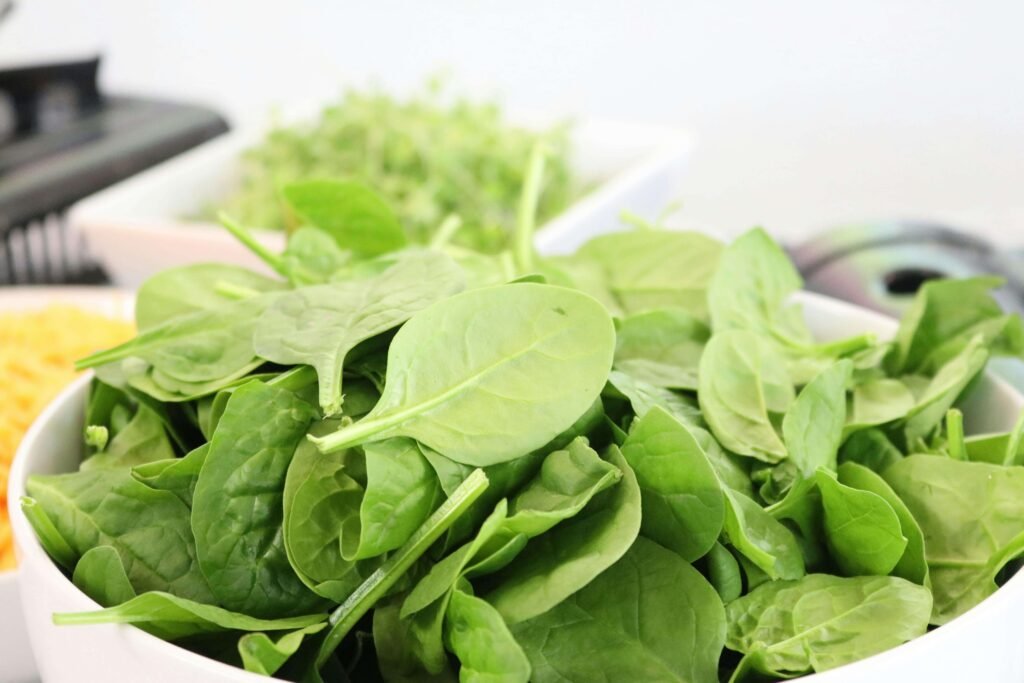
Why It’s Essential:
Spinach is loaded with iron, folate, and vitamins A & C, which enhance scalp circulation, reduce shedding, and support sebum production.
Scientific Insights:
- A 2021 study in The Journal of Clinical and Aesthetic Dermatology linked iron deficiency to telogen effluvium, a condition causing excessive shedding.
- Folate aids DNA repair in rapidly dividing follicle cells.
Nutritional Breakdown (1 Cup Cooked):
- Iron: 6.4mg (36% RDI)
- Vitamin A: 105% RDI
- Folate: 66% RDI
How to Include It in Your Diet:
- Green Smoothie: Blend spinach, pineapple (vitamin C), and Greek yogurt.
- Saag Aloo: An Indian dish with spinach, potatoes, and turmeric.
Synergy Tip: Pair spinach with lemon juice to boost iron absorption by 300%.
4. Avocados – Vitamin E for Hair Protection
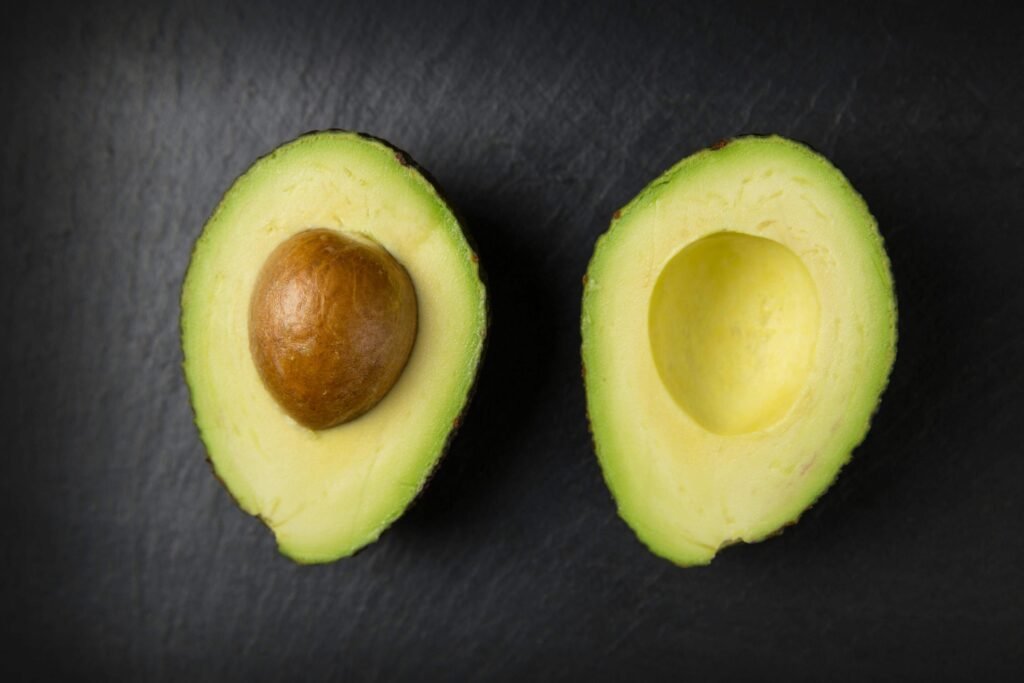
Why It’s Essential:
Avocados are packed with monounsaturated fats, vitamin E, and vitamin C, which combat oxidative stress, hydrate the scalp, and promote hair elasticity. Vitamin E acts as a shield against UV damage and pollution, preserving hair integrity.
Scientific Insights:
- A 2020 study in The Journal of Cosmetic Dermatology found that participants who consumed 200mg of vitamin E daily for 8 weeks experienced a 34.5% increase in hair count compared to a placebo group.
- The oleic acid in avocado oil penetrates the hair shaft, reducing protein loss and preventing split ends.
Nutritional Breakdown (1 Medium Avocado):
- Calories: 240
- Vitamin E: 28% of RDI
- Vitamin C: 22% of RDI
- Healthy Fats: 22g
How to Include It in Your Diet:
- Avocado Toast: Spread mashed avocado on whole-grain bread, topped with chili flakes and pumpkin seeds (zinc).
- Avocado Smoothie: Blend with spinach, banana, and almond milk for a nutrient-dense drink.
- DIY Hair Mask: Mix mashed avocado with coconut oil and honey. Apply to hair for 30 minutes to restore moisture.
Pro Tip: Use avocado oil as a pre-shampoo treatment to protect hair from heat styling damage.
5. Sweet Potatoes – Beta-Carotene for Hair recovery and Repair
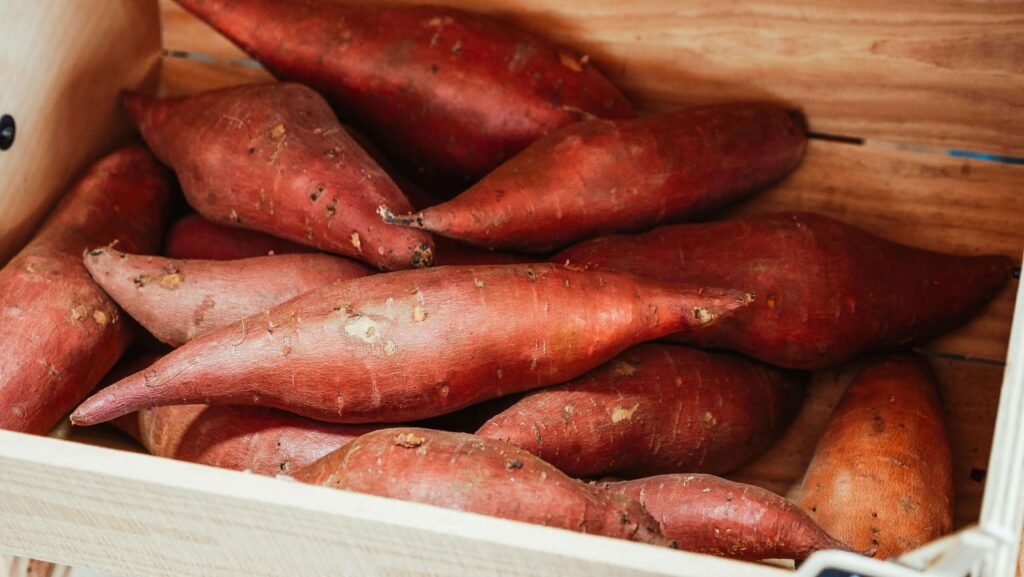
Why It’s Essential:
Sweet potatoes are rich in beta-carotene, a precursor to vitamin A, which regulates sebum production and repairs damaged scalp tissue. Vitamin A also accelerates cell turnover, promoting thicker, healthier strands.
Scientific Insights:
- A 2019 study in The Journal of Clinical and Aesthetic Dermatology linked vitamin A deficiency to dry, flaky scalp and reduced hair density.
- Beta-carotene’s antioxidant properties protect follicles from free radicals caused by environmental stressors.
Nutritional Breakdown (1 Medium Sweet Potato):
- Beta-Carotene: 400% of RDI
- Vitamin C: 37% of RDI
- Fiber: 6.6g
How to Include It in Your Diet:
- Sweet Potato Fries: Toss in olive oil and rosemary; bake at 400°F for 25 minutes.
- Mashed Sweet Potato: Mix with cinnamon (anti-inflammatory) and a dash of coconut milk.
- Sweet Potato Soup: Blend roasted sweet potatoes with ginger and turmeric for added scalp benefits.
Synergy Tip: Pair sweet potatoes with a source of healthy fat (e.g., avocado or olive oil) to maximize beta-carotene absorption.
6. Nuts & Seeds – Zinc & Antioxidants for Scalp Health
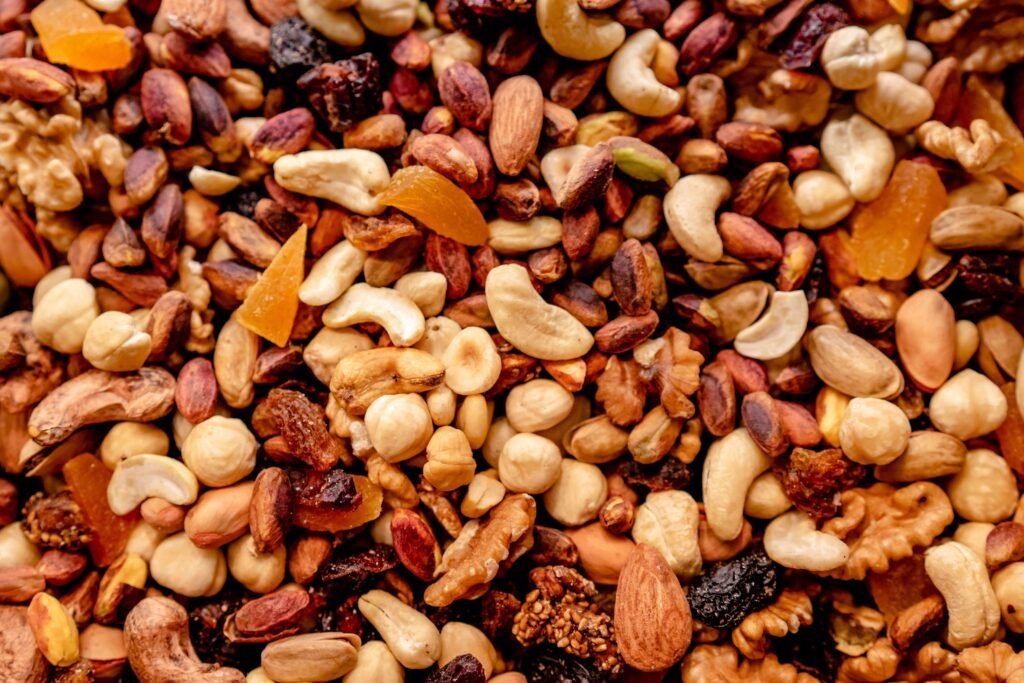
Why It’s Essential:
Nuts and seeds are loaded with zinc, vitamin E, selenium, and omega-3s, which reduce inflammation, balance hormone levels, and strengthen hair follicles. Zinc, in particular, regulates oil production and DNA synthesis in hair cells.
Scientific Insights:
- A 2022 meta-analysis in Dermatology Research and Practice found that zinc supplementation improved hair density in 85% of participants with alopecia.
- Selenium in Brazil nuts protects follicles from oxidative damage linked to premature graying.
Top Picks & Benefits:
- Almonds: High in vitamin E and magnesium.
- Walnuts: Rich in alpha-linolenic acid (plant-based omega-3).
- Pumpkin Seeds: Contain cucurbitacin, a compound that blocks DHT (a hormone linked to hair loss).
- Chia Seeds: Provide fiber and omega-3s for gut-hair axis health.
Nutritional Breakdown (1 oz of Pumpkin Seeds):
- Zinc: 2.2mg (20% RDI)
- Iron: 2.5mg (14% RDI)
- Protein: 8.5g
How to Include Them in Your Diet:
- Trail Mix: Combine almonds, walnuts, and dark chocolate (iron-rich) for a snack.
- Seed Cycling: Add ground flaxseeds and pumpkin seeds to oatmeal during follicular phase (hormone-balancing hack).
- Nut Butter: Spread almond butter on apple slices for a vitamin E boost.
Caution: Avoid overconsumption of Brazil nuts—1–2 daily provides enough selenium.
7. Greek Yogurt – Probiotics & Pantothenic Acid
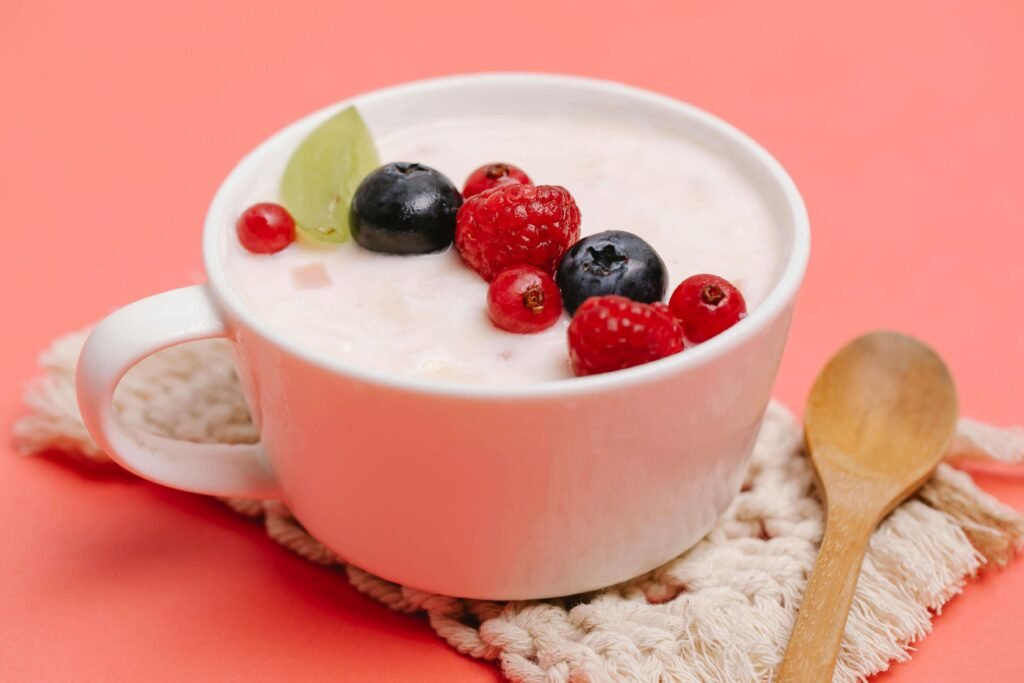
Why It’s Essential:
Greek yogurt is a probiotic powerhouse that supports gut health, which is directly linked to nutrient absorption and scalp inflammation. It’s also rich in vitamin B5 (pantothenic acid), which strengthens hair cuticles and reduces breakage.
Scientific Insights:
- A 2021 study in Current Developments in Nutrition showed that probiotics in yogurt reduce scalp inflammation by balancing the gut microbiome.
- Vitamin B5 improves hair elasticity and shine by sealing the hair cuticle.
Nutritional Breakdown (1 Cup Non-Fat Greek Yogurt):
- Protein: 23g
- Vitamin B5: 20% of RDI
- Calcium: 20% of RDI
How to Include It in Your Diet:
- Yogurt Parfait: Layer with berries, granola, and a drizzle of manuka honey.
- Savory Dip: Mix yogurt with garlic, dill, and cucumber as a veggie dip.
- Hair Rinse: Combine yogurt with apple cider vinegar for a clarifying scalp treatment.
Vegan Alternative: Coconut yogurt fortified with B vitamins.
8. Berries – Antioxidants for Hair Protection
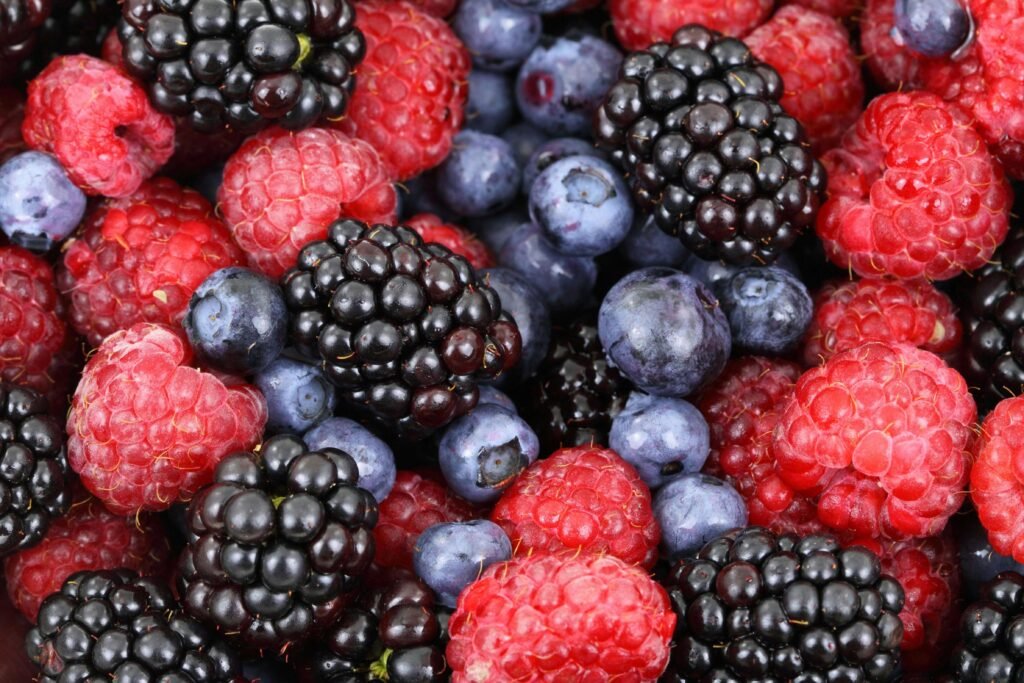
Why It’s Essential:
Berries like strawberries, blueberries, and raspberries are bursting with vitamin C, anthocyanins, and ellagic acid, which neutralize free radicals, boost collagen production, and protect hair from UV damage.
Scientific Insights:
- A 2020 study in Nutrients found that vitamin C increases iron absorption by up to 67%, addressing a key cause of hair shedding.
- Anthocyanins in blueberries improve blood flow to the scalp, nourishing follicles.
Nutritional Breakdown (1 Cup Blueberries):
- Vitamin C: 24% of RDI
- Fiber: 3.6g
- Antioxidants: 13,427 ORAC units
How to Include Them in Your Diet:
- Berry Smoothie Bowl: Top with granola and shredded coconut for added texture.
- Chia Berry Jam: Simmer mixed berries with chia seeds for a hair-healthy spread.
- Berry Ice Cubes: Freeze blended berries in ice trays to add to water or smoothies.
Pro Tip: Opt for organic berries to minimize pesticide exposure, which can disrupt hormone balance.
9. Lentils – Plant-Based Protein & Iron Source
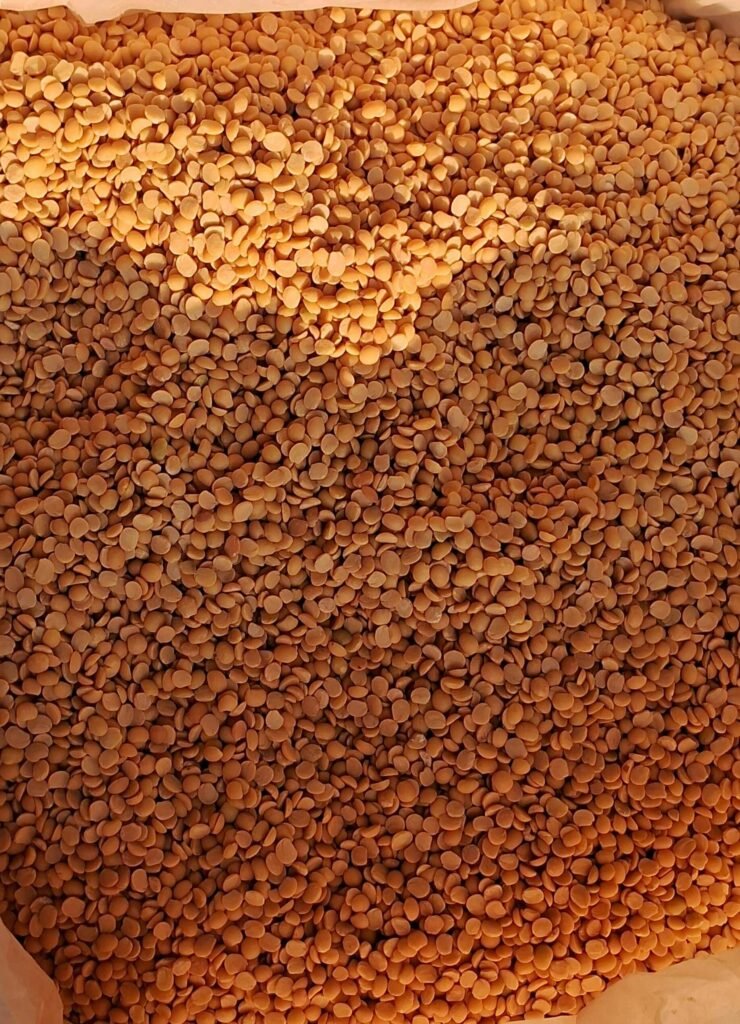
Why It’s Essential:
Lentils are a powerhouse of plant-based protein, iron, folate, and zinc, making them ideal for repairing damaged hair and supporting follicle regeneration. Their high fiber content also aids gut health, which is critical for nutrient absorption and reducing inflammation linked to hair loss.
Scientific Insights:
- A 2019 study in Dermatology Practical & Conceptual found that low protein and iron intake correlated with telogen effluvium, a condition where hair prematurely enters the shedding phase.
- Folate in lentils supports DNA synthesis in hair follicles, ensuring healthy cell division and growth.
Nutritional Breakdown (1 Cup Cooked Lentils):
- Protein: 18g
- Iron: 6.6mg (37% RDI)
- Folate: 90% of RDI
How to Include Them in Your Diet:
- Lentil Curry: Simmer lentils with coconut milk, turmeric, and spinach for a nutrient-dense meal.
- Lentil Salad: Toss cooked lentils with roasted veggies, olive oil, and lemon juice.
- Lentil Pasta: Swap regular pasta for lentil-based noodles to boost protein intake.
Vegan Tip: Pair lentils with vitamin C-rich foods like bell peppers or tomatoes to enhance iron absorption.
10. Oysters – The Ultimate Zinc-Rich Superfood
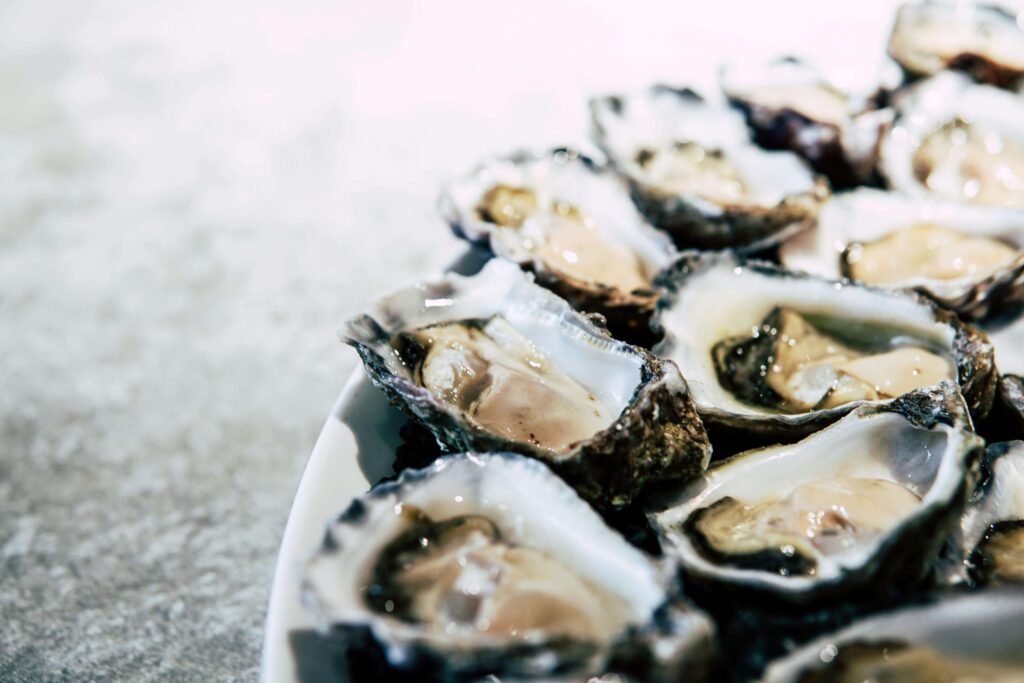
Why It’s Essential:
Oysters are the richest natural source of zinc, a mineral vital for hair follicle function, sebum regulation, and DNA repair. Just one serving provides over 500% of the daily zinc requirement, addressing deficiencies linked to alopecia and slow growth.
Scientific Insights:
- A 2020 study in Annals of Dermatology found that zinc supplementation reduced hair shedding by 50% in individuals with zinc deficiency.
- Zinc inhibits 5-alpha-reductase, an enzyme that converts testosterone to DHT (a hormone linked to pattern baldness).
Nutritional Breakdown (6 Medium Oysters):
- Zinc: 33mg (300% RDI)
- Protein: 6g
- Vitamin B12: 400% of RDI
How to Include Them in Your Diet:
- Grilled Oysters: Top with garlic, parsley, and lemon juice for a simple appetizer.
- Oyster Stew: Simmer with coconut milk, ginger, and kale for a warming dish.
- Alternatives: For non-seafood eaters, opt for pumpkin seeds (zinc) or zinc supplements (consult a doctor first).
Caution: Avoid raw oysters if pregnant or immunocompromised. Cook thoroughly to reduce infection risk.
Final Thoughts: Building a Hair-Healthy Diet
While these 10 foods are foundational, holistic hair care involves more than just diet:
- Hydration: Drink 2–3 liters of water daily to keep hair and scalp hydrated.
- Stress Management: Chronic stress shortens the hair growth cycle. Practice yoga, meditation, or deep breathing.
- Avoid Over-Styling: Limit heat tools and tight hairstyles that cause breakage.
- Supplement Wisely: Consider biotin, collagen, or multivitamins if dietary gaps persist (under medical guidance).
Your Hair Recovery Journey Starts Now
Incorporate these foods consistently for 3–6 months to see visible improvements in thickness, shine, and growth. Track progress with photos and note changes in shedding or texture.
What’s Next?
Disclaimer: This guide is not a substitute for medical advice. Consult a dermatologist for persistent hair loss.


Leave a Reply